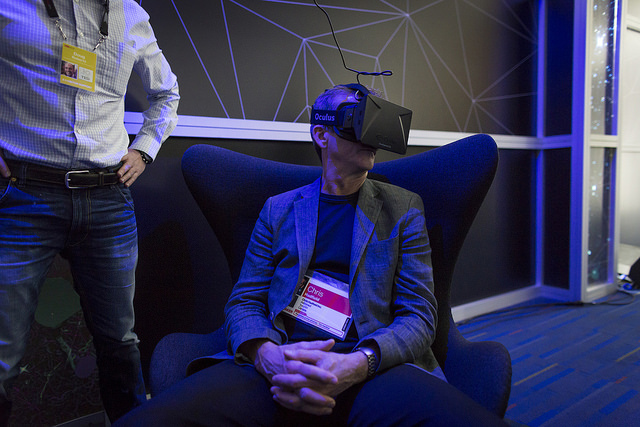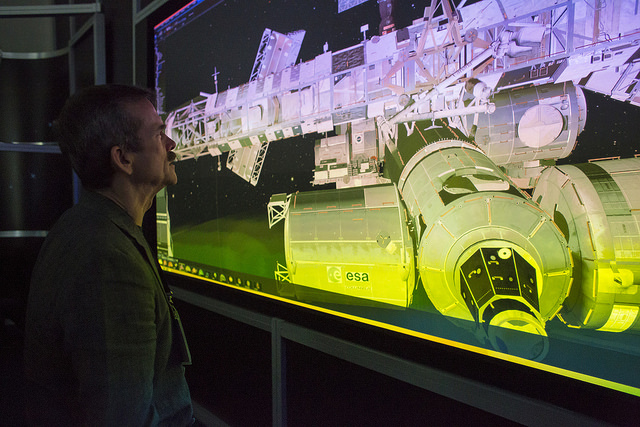
Floating in a most peculiar way: Astronaut Chris Hadfield sports an Oculus Rift headset at TED2014. Photo: Ryan Lash.
Oculus VR may have won the headlines today by, you know, being acquired by Facebook for $2 billion. But last week it won the hearts and minds of the TED crowd. First, former NFL punter Chris Kluwe showed footage of a guy wearing an Oculus Rift headset and riding a virtual rollercoaster (video shown, bottom — jump to the 1:10 mark to watch things really get interesting). Kluwe, discussing the challenge of making sports more entertaining and engaging for spectators, asked the literal multi-million dollar question, “How do we make it more immersive?” His answer: “We take that next step by going to something called the Oculus Rift. This has been described as one of the most realistic virtual reality devices ever created. That is not empty hype.”

Chris Hadfield admires a virtual representation of the International Space Station at TED2014. Photo: Ryan Lash.
Speakers and attendees got to judge for themselves; an exhibit curated by Jonathan Fay of Microsoft, Amy Robinson of MIT with Phil Klein of TED featured two Oculus Rift virtual reality stations. People lined up to try out the headset and spin through various scenarios, including a first-ever 3D view of neurons and a virtual tour of the International Space Station, based on data from the World Wide Telescope project, supported by Microsoft Research. Who better to try *that* out than astronaut Chris Hadfield, who compared fake space with his memory of the real thing (see also his wonderful talk, What I learned from going blind in space). All pretty impressive, said our intrepid explorer, though he did pick up on a few discrepancies. For instance, the virtual visibility was literally incredible. The view from space is amazing, but it seems things aren’t *that* clear when you’re thousands of miles up in the air.
Nonetheless, it’s that kind of clarity that likely drove today’s acquisition, and Facebook founder Mark Zuckerberg to write, giddily, “This is really a new communication platform. By feeling truly present, you can share unbounded spaces and experiences with the people in your life. Imagine sharing not just moments with your friends online, but entire experiences and adventures.” Imagine, indeed.
[youtube http://www.youtube.com/watch?v=GoQ0OXJCbaE&w=560&h=315%5D
And, here’s TED speaker and attendee, Julian Treasure, who recorded his response to the exhibit:
Comments (14)
Pingback: Eyewire Announces BrainVR: Explore the Complexity of the Mind in New Dimensions at Tribeca Film Festival
Pingback: Eyewire Announces BrainVR: Explore the Complexity of the Mind in New Dimensions at Tribeca Film Festival – ePRNews
Pingback: BrainVR: One Step Closer to Visualizing the Brain in Virtual Reality - Amy Robinson Sterling
Pingback: Eyewire’s BrainVR at Tribeca Film Festival
Pingback: Simplexity in Knotty Objects: MIT Media Lab’s First Design Summit
Pingback: How To Use World Wide Telescope
Pingback: EyeWire Neurons in Virtual Reality at TED 2014
Pingback: EyeWire Weekly Update x2
Pingback: TED2014–Virtual Reality in Space - Dan on eScience & Technical Computing @ Microsoft - Site Home - MSDN Blogs
Pingback: Video games | A great BIG world